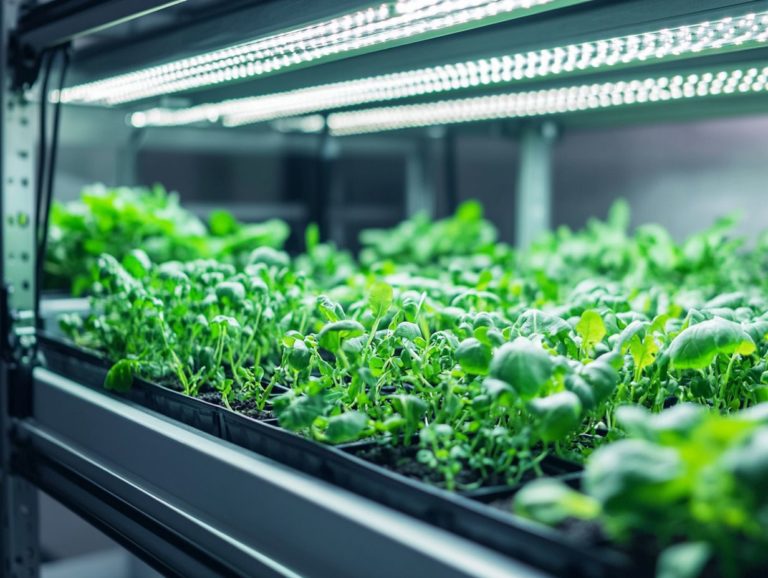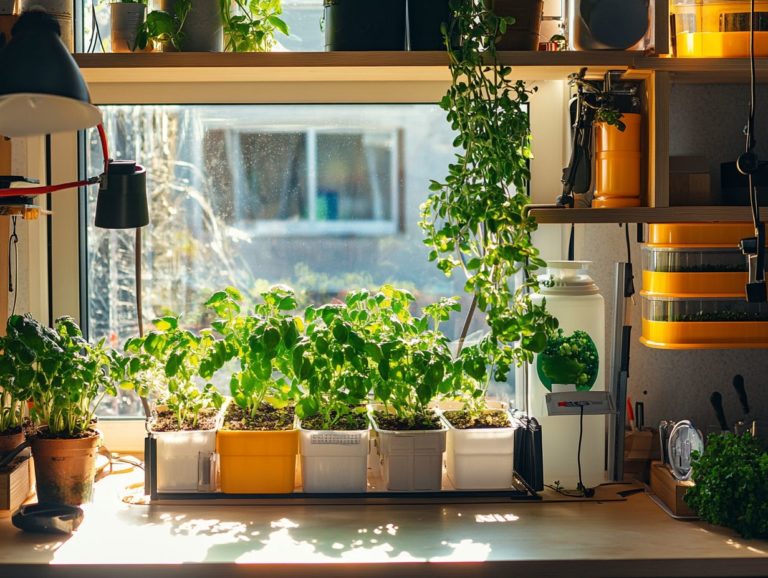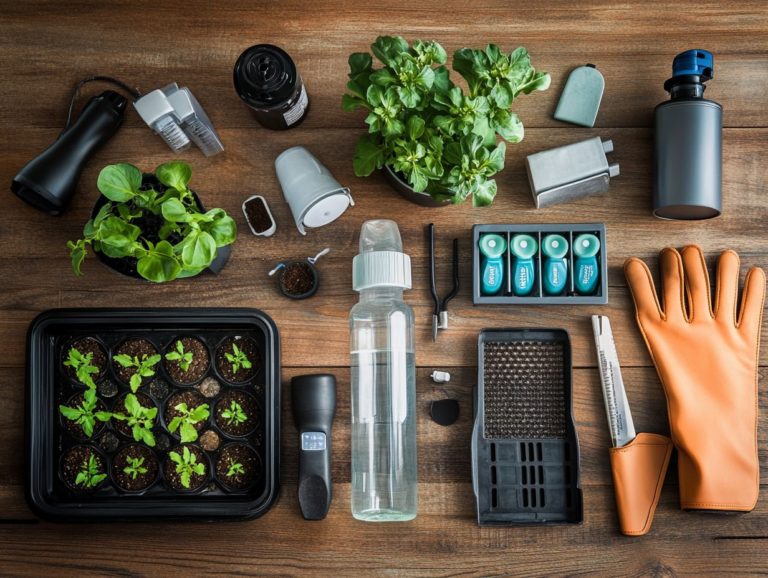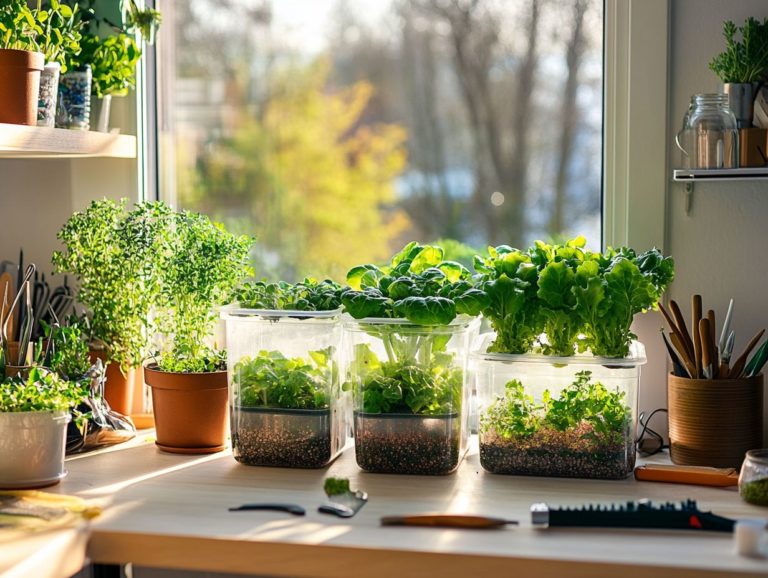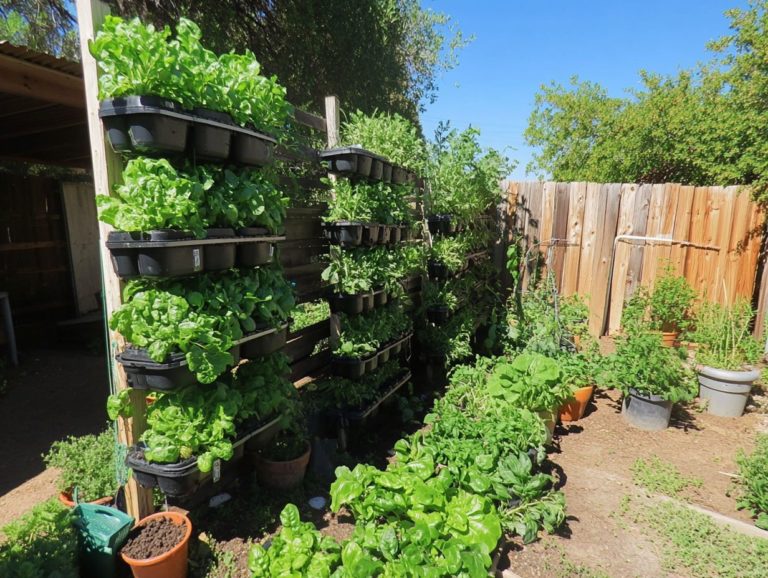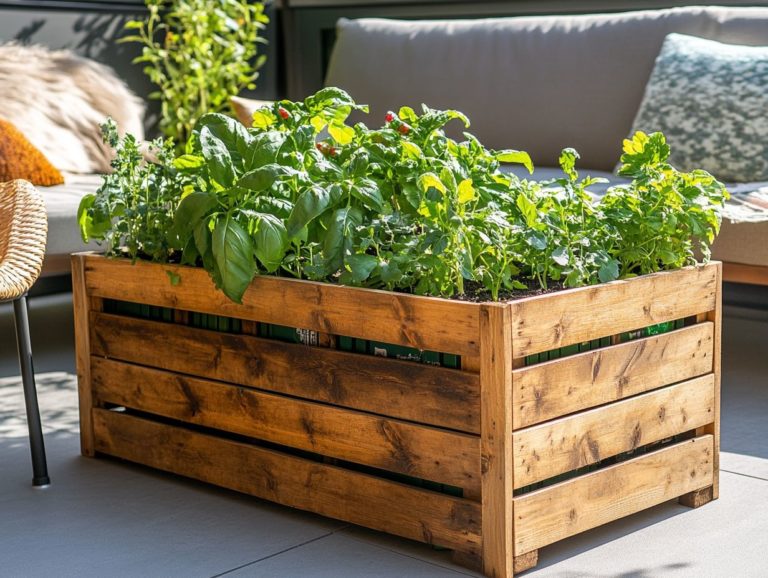Building a Hydroponic System from Scratch
Hydroponics is revolutionizing the way you approach gardening, enabling you to cultivate plants without the need for soil.
This guide invites you to embark on the exciting journey of building your very own hydroponic system from the ground up. Uncover the myriad benefits, from cost savings to unparalleled customization, and familiarize yourself with the various designs available for your system.
You’ll find a comprehensive overview of essential materials, accompanied by step-by-step assembly instructions and troubleshooting tips to ensure your success.
Whether you’re just starting out or already have a green thumb, this guide offers valuable insights to elevate your hydroponic gardening experience.
Don t miss out dive in now and unlock the amazing potential of soilless cultivation!
Contents
- Key Takeaways:
- Benefits of Building Your Own System
- Choosing the Right Hydroponic System Design
- Materials and Tools Needed
- Step-by-Step Guide to Building a Hydroponic System
- Troubleshooting and Maintenance
- Tips for Successful Hydroponic Gardening
- Frequently Asked Questions
- What materials do I need to build a hydroponic system from scratch?
- Can I use any container or reservoir for my hydroponic system?
- What is the best growing medium for a hydroponic system?
- Do I need to buy specific nutrients for my hydroponic system?
- How often do I need to check and adjust the pH level of my hydroponic system?
- Can I use tap water in my hydroponic system?
Key Takeaways:
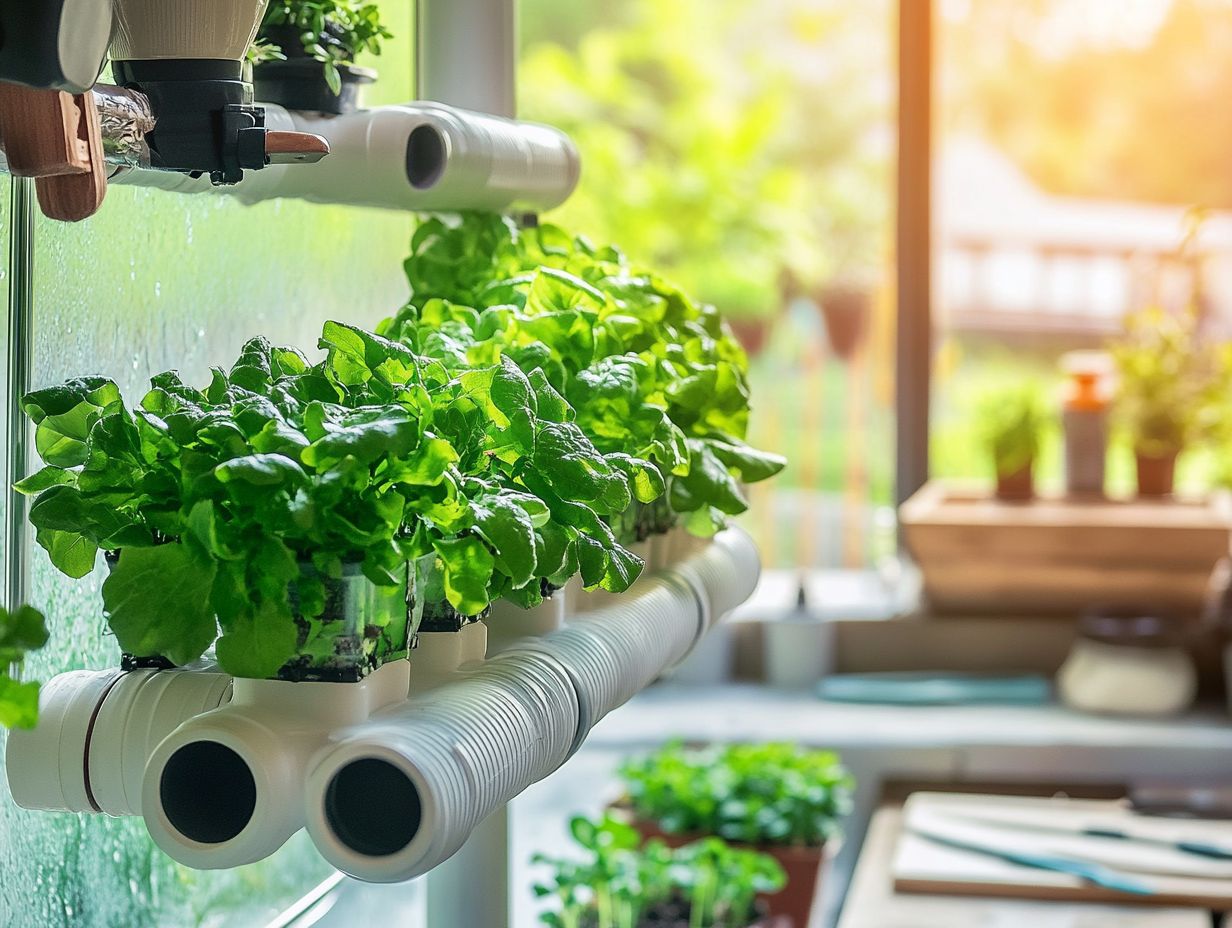
- Save money and customize your hydroponic system by building it from scratch.
- Consider factors such as space, budget, and plant type when choosing the right system design for your needs.
- Follow a step-by-step guide and proper maintenance for a successful and thriving hydroponic garden.
What is Hydroponics?
Hydroponics offers you an innovative approach to growing plants without the need for soil, using nutrient-rich water solutions that deliver essential nutrients directly to the roots. Whether you choose to implement this technique indoors or outdoors, you ll find that it promotes remarkably efficient growth cycles, conserves water, and allows for year-round cultivation of a variety of crops, from herbs to vegetables.
With systems like deep water culture, nutrient film technique (which involves a thin film of nutrient solution flowing over the roots), and aeroponics at your disposal, you can ensure optimal plant health and yield.
The roots absorb minerals and oxygen from the water, fostering faster growth and healthier plants. Hydroponics, with roots traceable back to the ancient civilizations of Babylon, has evolved rapidly alongside technological advancements, making it a preferred option for today s modern gardeners.
The key principles in hydroponics revolve around precise control of pH levels, temperature, and nutrient composition, all of which enhance crop resilience and productivity. One standout advantage of this method compared to traditional gardening is its ability to maximize space. This means you can cultivate fresh produce even in compact urban environments while slashing water usage by up to 90%.
Benefits of Building Your Own System
Building your own hydroponic system opens up exciting advantages, from considerable cost savings to the freedom to customize your setup according to your unique vision. You can choose materials like PVC pipes and net cups, and design irrigation systems that seamlessly fit within your space.
A tailored hydroponic garden enhances your ability to grow indoor vegetables and herbs that cater specifically to your tastes and requirements. This allows for sustainable plant cultivation year-round, ensuring you have a steady supply of fresh produce regardless of the season.
Cost Savings and Customization
One of the key benefits of establishing your own hydroponic setup is the significant cost savings. You can source materials and tools according to your budget, avoiding the hefty price tags of pre-made systems. This customization allows you to design your hydroponic garden to meet your specific needs, whether you re cultivating herbs, leafy greens, or other indoor vegetables.
This flexibility enhances your gardening experience and opens the door to experimenting with various hydroponic methods, including how to design a hydroponic greenhouse, optimizing plant care and growth.
By utilizing readily available materials like PVC pipes for the framework or repurposed containers for reservoirs, you can substantially cut costs. Incorporating LED grow lights or affordable water pumps can enhance efficiency without straining your finances. Additionally, learning how to set up a deep water culture system allows you to tailor these elements, ensuring each hydroponic system is budget-friendly and perfectly aligned with your unique environment and preferences.
Engaging in this hands-on approach deepens your understanding of plant growth while maximizing yield, making it an enticing option for both newcomers and seasoned cultivators alike.
In conclusion, hydroponics offers a fantastic opportunity to innovate in your gardening practices while reaping significant benefits. Start your hydroponic journey today!
Choosing the Right Hydroponic System Design
Choosing the right hydroponic system design is essential for achieving success in indoor gardening. It can profoundly influence plant growth, yield, and maintenance efforts.
Several hydroponic systems are available, including deep water culture, nutrient film technique, and aeroponics. Each system boasts unique features tailored to grow plants efficiently in confined spaces.
By understanding the benefits and limitations of each system, you can select a design that aligns perfectly with your gardening aspirations, whether you’re aiming for vertical gardening or looking to optimize every inch of your compact space.
Types of Hydroponic Systems
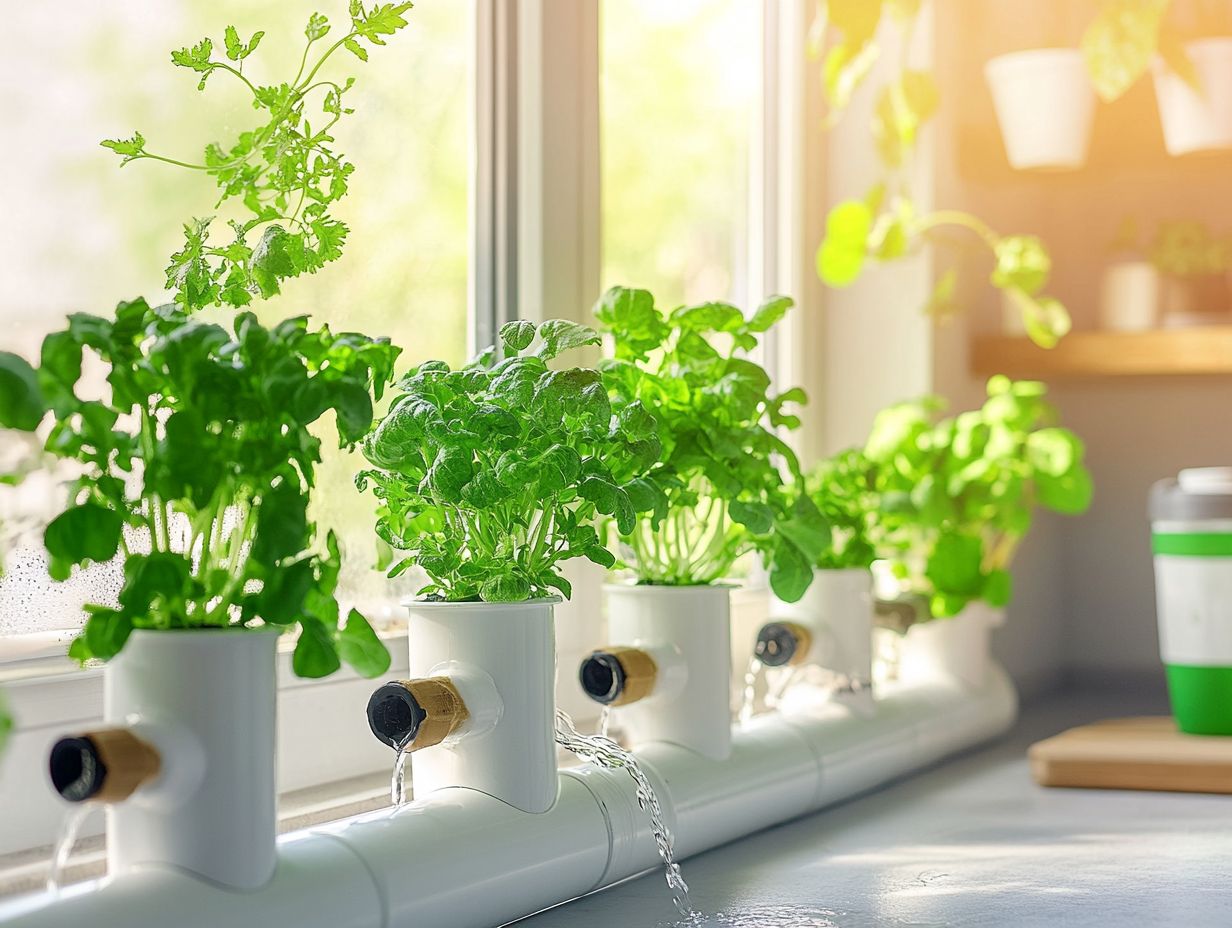
You ll discover several types of hydroponic systems, each with its own distinctive approach to growing plants without soil. These include deep water culture, nutrient film technique, and aeroponics.
Each system has its unique strengths, perfect for different gardening needs! For example, deep water culture is excellent for leafy greens like lettuce. Its straightforward design allows roots to flourish in oxygen-rich water.
Nutrient film technique uses a thin film of nutrient solution to feed plants, making it ideal for cultivating strawberries and herbs, as it creates an optimal balance of moisture and oxygen.
Aeroponics is especially beneficial for high-value crops such as basil and mint. This method boosts growth through efficient nutrient delivery while minimizing water usage.
These diverse methods highlight the remarkable versatility of hydroponics, making it an excellent choice for both hobbyists and commercial growers. You can maximize yield and resource efficiency with the right system!
Factors to Consider
When choosing a hydroponic system, consider several key factors for optimal plant growth and yield. Think about the system design, water management, and nutrient availability.
Your available space, budget, and the types of plants you plan to grow will significantly influence your choices. Incorporating tools like a pH meter and water pump can elevate your nutrient management and ensure healthy plant care.
If you’re a small urban gardener, lean towards vertical systems that maximize limited space while being budget-friendly. This allows you to effortlessly cultivate herbs or leafy greens.
If you have a larger area, explore advanced setups like deep water culture or aeroponics, which can support a wider range of plant varieties.
Don’t forget to consider the costs of essential tools and ongoing expenses for water and nutrient solutions. Your hydroponic system must align with your financial resources and gardening goals, and using DIY hydroponic system plans for beginners can help you achieve the best results.
Materials and Tools Needed
Establishing your hydroponic setup involves gathering a range of materials and tools designed to promote optimal plant growth. You’ll need PVC pipes to create the structure, net cups to hold your plants, and a well-designed reservoir for nutrient solutions.
Essential tools for assembly include a power drill, hole saw, and clear aquarium silicone. Water pumps and growth mediums like Rockwool or clay pebbles are key components for maintaining an efficient irrigation system.
With the right materials at your fingertips, you ll ensure a smoother building process and set the stage for successful indoor gardening.
Gather your materials today to kickstart your indoor garden!
Essential Components
The essential components of your hydroponic system include a reliable water pump, nutrient solution, and net cups. These elements work together to provide your plants with the vital resources they need for healthy growth.
Don t overlook the importance of oxygenation. It plays a critical role in promoting root respiration, which is the process by which plants take in oxygen through their roots, and enhances overall plant vigor. An air pump, typically paired with air stones, infuses the water with oxygen, ensuring your root systems remain healthy and thriving.
Keep a close watch on the pH level of your nutrient solution to ensure your plants are thriving! Plants flourish within a specific pH range, so monitoring is key. A grow light system ensures your plants receive enough light, which is essential for photosynthesis, especially in indoor settings. Together, these components create a harmonious ecosystem that fosters robust plant development.
Optional Additions
While the essential components are vital for any hydroponic setup, several optional additions can truly elevate your gardening game. Don’t miss out on tools like a Kedsum pump to enhance water delivery or a pH meter for keeping a close eye on nutrient solution levels. These devices streamline your gardening process and help maintain optimal growing conditions, leading to healthier plants and higher yields.
You might also explore supplemental lighting for indoor gardening or automated irrigation systems. These can simplify your maintenance efforts.
Incorporating a quality nutrient delivery system, like Dosatrons or fertilizer injectors, can further optimize nutrient absorption. This ensures your plants receive the right amounts of essential elements at each growth stage. Implementing humidity controllers can significantly enhance moisture management, reducing stress and promoting better development across various plant types.
Visual monitoring tools, such as plant health cameras, offer real-time tracking of growth progression. This allows you to intervene promptly when necessary. By blending these enhancements into your hydroponic setup, you can create an environment that fosters robust health and thriving yields.
Step-by-Step Guide to Building a Hydroponic System
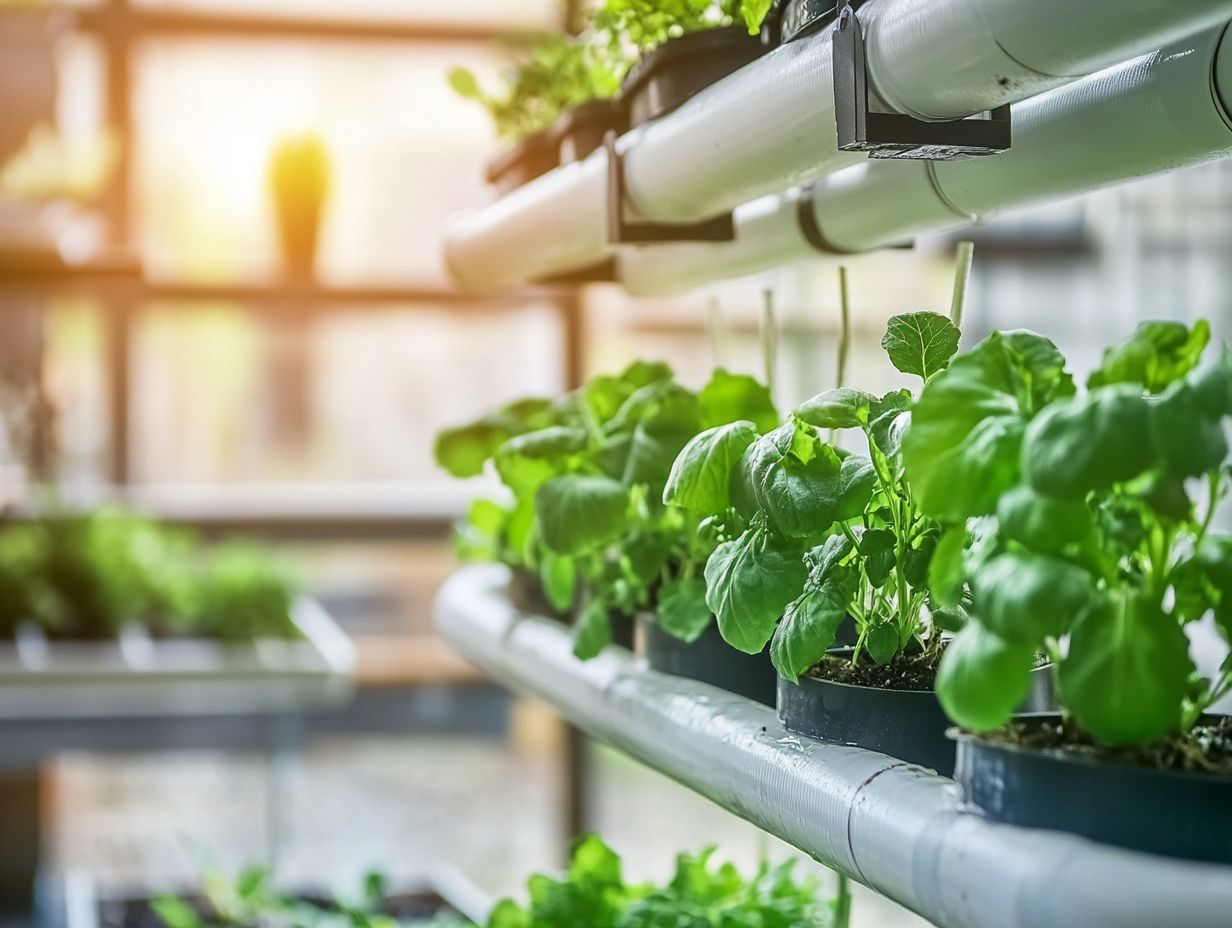
A step-by-step guide to building hydroponic systems can transform the process into a seamless experience, making it accessible even for those who are just beginning their indoor gardening journey.
Start by gathering essential materials like PVC pipes, water pumps, and net cups. Prepare your reservoir for nutrient solutions.
Follow these assembly steps carefully to create a structured approach that helps you navigate common pitfalls. This meticulous planning and execution will set the stage for optimal conditions, ensuring your plants thrive in their new hydroponic home.
Assembly and Setup Instructions
When assembling your hydroponic system, it s essential to follow the setup instructions meticulously to ensure that every component operates effectively and efficiently. Begin with constructing the reservoir, which will hold your nutrient solution, and then assemble the main structure using PVC pipes.
Position the water pump correctly to optimize the circulation of the nutrient solution. To learn more about effective setups, refer to understanding the basics of hydroponic systems. Additionally, place your net cups strategically to maximize the plants’ exposure to light.
Consider how to secure the system to prevent any unwanted movements that could disrupt the water flow or the positioning of your plants. It’s also crucial to ensure that the nutrient solution is compatible with your selected crops, as different plants have varying needs. For those looking to set up their own, you can refer to this guide on how to build a simple hydroponic system. Keep a close eye on the pH levels, temperature, and the overall health of your growing plants within the system to avoid growth issues.
Many skilled gardeners find that covering the nutrient reservoir helps mitigate common problems related to algae growth. Observing your plants closely during their initial stages will enable you to spot any signs of nutrient deficiencies or excesses, allowing for prompt adjustments that can make all the difference.
Troubleshooting and Maintenance
Troubleshooting and maintenance are essential components of managing hydroponic systems. They ensure your plants thrive and remain productive throughout their growth cycle. You may encounter common issues such as nutrient deficiencies, algae growth, or equipment malfunctions, each demanding tailored strategies for resolution.
Regularly inspecting the water reservoir, monitoring pH levels, and assessing overall system functionality are crucial steps in maintaining optimal conditions for plant health. For those looking to set up their own system, building a hydroponic system on a budget can be a great starting point. Actively monitoring your system helps you tackle challenges quickly, keeping your hydroponic garden flourishing.
Common Issues and How to Address Them
Common issues in hydroponic systems often include nutrient deficiencies, algae growth, and improper water circulation. Each requires specific solutions for effective resolution. You can often remedy nutrient deficiencies by adjusting the composition of your nutrient solution. Managing light exposure and maintaining system cleanliness can help keep algae at bay. It’s essential to monitor and adjust water circulation to prevent stagnation, ensuring your plants receive a consistent supply of nutrients and oxygen.
Inadequate pH levels can disrupt plant health, making regular testing and adjustments a priority for you as a grower. Pest infestations may also surface, necessitating ways to control pests to safeguard your crops while preserving the ecosystem.
Regular maintenance checks on pumps and filters not only extend the life of your system but also enhance its performance. This allows you to minimize potential issues before they escalate. By embracing a holistic approach to troubleshooting, you can cultivate thriving plants, ultimately boosting your yield and overall success.
Tips for Successful Hydroponic Gardening
To achieve optimal growth and yield in hydroponic gardening, implementing targeted strategies can significantly enhance your gardening success. Focus on monitoring nutrient levels, maintaining a proper pH balance, and ensuring your plants receive adequate light exposure.
Regular system maintenance is key. Closely observing plant health enables you to detect early signs of distress. This proactive approach allows for timely adjustments and care, setting the stage for thriving plants and bountiful harvests. Start today to boost your garden’s health and productivity!
Best Practices for Optimal Growth and Yield

Implementing best practices for optimal growth and yield in hydroponic gardening is essential for nurturing healthy, productive plants.
By carefully balancing nutrient solutions and paying attention to the specific needs of your plants at various growth stages, you can significantly enhance nutrient absorption and overall plant vitality. Keeping your hydroponic systems free from algae and pathogens through regular cleaning preserves the integrity of your nutrient solution and prevents diseases that can impede growth. For those interested in taking it a step further, consider building a vertical hydroponic garden at home to maximize your gardening space.
Understanding and managing light requirements effectively ensures that your plants receive the right spectrum and duration of light. This is crucial for photosynthesis and maximizing yield. By integrating these strategies, you can achieve an impressive harvest that truly showcases the potential of hydroponic gardening.
Frequently Asked Questions
What materials do I need to build a hydroponic system from scratch?
To build a basic hydroponic system, you will need a container or reservoir, an aerator, growth medium, nutrients, and plants. Optional materials can include a water pump, grow lights, and a pH testing kit.
Can I use any container or reservoir for my hydroponic system?
Yes, you can use any clean and sturdy container as long as it can hold water and has a lid. Popular options include plastic storage bins, buckets, and large food-grade containers.
What is the best growing medium for a hydroponic system?
There are various options for growing mediums, such as perlite, vermiculite, and coconut coir. It’s important to choose a medium that promotes good drainage and aeration while providing support for plant roots.
In summary, effective troubleshooting, regular maintenance, and adopting best practices are vital for successful hydroponic gardening. For those looking to enhance their setup, learning how to create a floating raft hydroponic system can provide additional benefits. With these strategies, you can ensure your plants thrive and maximize your yields.
Do I need to buy specific nutrients for my hydroponic system?
Yes, plants in a hydroponic system need different plant nutrients than those grown in soil. You can buy ready-made nutrient solutions or create your own using water and specific fertilizers.
How often do I need to check and adjust the pH level of my hydroponic system?
Check and adjust the pH level regularly, ideally every 1-2 weeks. The best pH range for most plants is between 5.5 and 6.5.
Can I use tap water in my hydroponic system?
You can use tap water, but test and adjust the pH level first. It s better to use filtered or distilled water to avoid potential problems.

